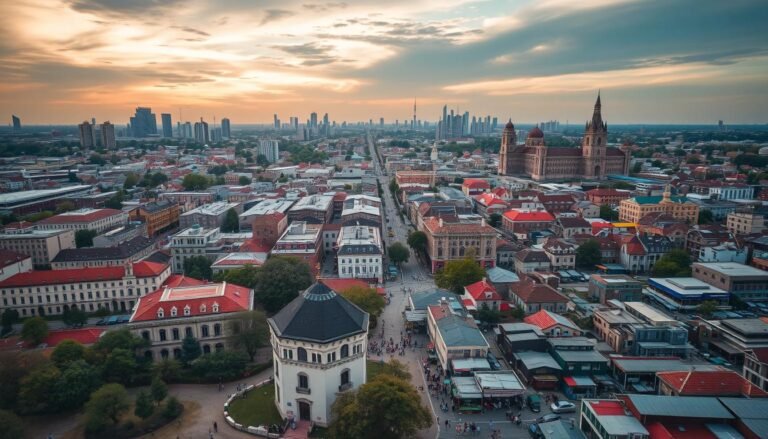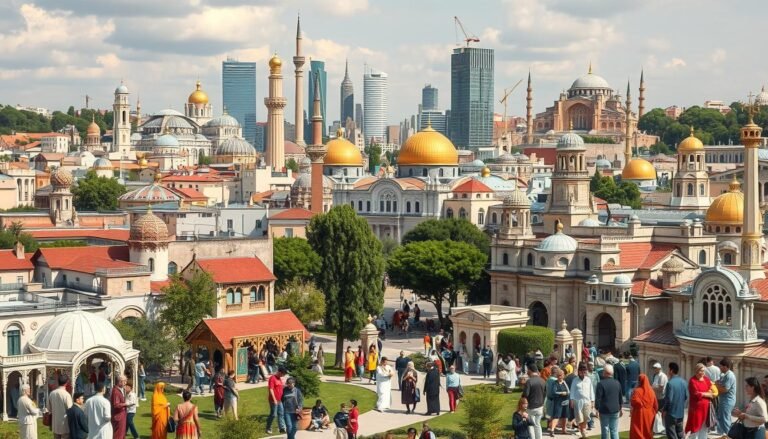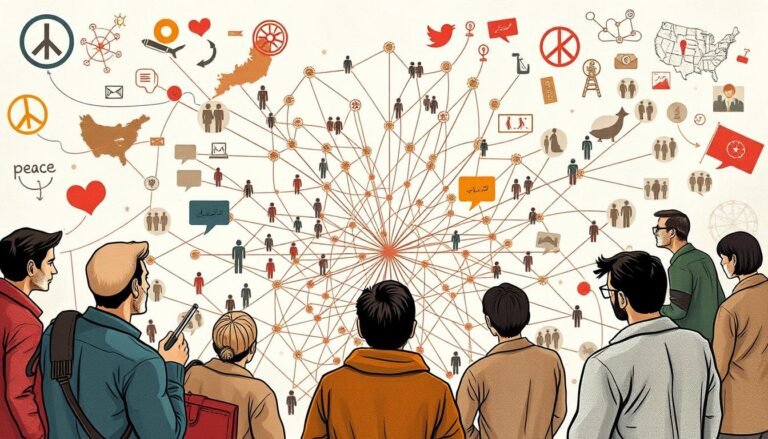Sociological Insights into Environmental Justice
Have you ever thought about how our society affects our relationship with the environment? This is what environmental sociology is all about. It looks at how people and nature interact. By studying this, we learn a lot about the big environmental problems we face and why we respond to them the way we do.
Environmental justice is a big part of this study. It shows that not everyone gets the same benefits or faces the same problems from the environment. This field uses sociology, ecology, and geography to understand how people and their environment work together.
When we dive into environmental sociology, we see how our social setup, culture, and who has power affect how we see nature. We also see how nature affects our societies. This creates a cycle that we need to pay attention to and act on.
Key Takeaways
- Environmental sociology looks at how society and nature interact with each other.
- This field combines ideas from sociology, ecology, and environmental studies.
- Environmental justice is about how some groups get more environmental problems than others.
- Our social life, like culture and power, shapes how we see nature.
- Knowing these insights is key to solving our environmental issues.
Understanding Environmental Justice: A Sociological Perspective
Environmental justice is key in sociology, linking environmental issues with fairness. It shows how some communities face more environmental harm, often because of race or money.
Defining Environmental Justice
Environmental justice means everyone gets a fair shot in environmental decisions. It points out how some places, usually poor and black, carry more pollution. Sociologists show how racism affects these differences.
Sociology Meets Environmental Studies
Sociology and environmental studies together give us a new way to look at fairness in nature. They show how society’s rules affect who gets hit by environmental problems. It puts people at the center of nature’s issues, not just science.
Historical Context
The fight for environmental justice started in the 1980s, with a big protest in Warren County, North Carolina. People were against a PCB landfill in a black, poor area. This event showed how race, poverty, and pollution are linked, sparking more action and research.
“Environmental justice fuses environmental and social justice issues by focusing on environmental racism in communities of color.”
Groups like the United Church of Christ and the U.S. General Accounting Office have found that people of color face more environmental dangers. These facts highlight the need to fight environmental racism and make sure all communities are treated fairly.
The Social Construction of Nature and Its Impact on Environmental Justice
Our view of nature is shaped by society. This idea shows how culture affects what we see as natural or not. It’s key to solving environmental justice issues.
Environmental justice has become more important lately. A book from 2007, “Environmental Justice and Environmentalism,” looks at how these two ideas connect. It talks about how where we are in society changes our views on the environment and our actions.
Mainstream environmental groups often focus on lobbying because they can talk to lawmakers easily. But, environmental justice groups prefer actions like protests. These choices come from their different backgrounds and where they stand in society.
“Claims are complaints or grievances about social conditions that members of society find offensive, undesirable, or unjust.”
Environmental discussions use powerful words. Words like loss, unreason, calamity, entitlement, and endangerment shape how we see nature. They also affect decisions on policies.
The idea that nature’s view changes with society is important. Our views on the environment change with cultural shifts and power changes. Understanding this helps us find fair solutions to environmental problems.
Environmental Inequality: Unequal Distribution of Ecological Burdens
Environmental inequality means some communities carry more of the environmental load than others. Studies show that people’s economic status greatly affects their risk from the environment.
Socioeconomic Factors and Environmental Risk
Lower-income groups and minorities often face more environmental dangers. They are exposed to air pollutants, hazardous waste, and harmful pesticides. This leads to serious health issues, like black children having higher lead levels in their blood than white children.
Racial Disparities in Environmental Hazards
Research on environmental justice shows big racial differences in facing environmental risks. Minorities tend to live closer to polluting industries and contaminated areas. This makes the environmental burden even heavier on them, adding to social inequalities.
Geographic Patterns of Injustice
Where you live greatly affects your exposure to environmental injustice. Studies in Europe show that poorer areas have more environmental risks. These risks come from where polluting activities are placed, how power is distributed, and racism in housing and planning.
| Region | Key Environmental Justice Issues |
|---|---|
| USA | Air pollution, hazardous waste, contaminated fish |
| Europe | Residential environmental risks, planning inequities |
| Global South | Ecological distribution conflicts, defender killings |
The fight for environmental justice is global. In 2016, 200 environmental defenders were killed. This shows the ongoing struggle against environmental inequalities. Research is showing us that solving these issues needs a wide approach, looking at both physical and social factors.
Environmental Racism: Examining the Role of Race in Environmental Policies
Environmental racism shows how race affects environmental policies. It talks about how communities of color carry a bigger burden from the environment. Studies show African Americans are three times more likely to die from asthma than others, showing health issues linked to where they live.
The link between race and the environment became clear in 2020. Millions in the US joined protests for racial justice after George Floyd’s death. This movement made people talk more about how systemic racism affects environmental decisions.
The US Environmental Protection Agency planned to create a new office for environmental injustices in September 2022. This shows the need for special policies to help marginalized communities.
“Environmental justice is not just a buzzword. It’s a critical lens through which we must view all environmental policies to ensure equitable outcomes for all communities.”
Studies show that a neighborhood’s race often affects its environmental hazards more than its wealth. Black, white, and Hispanic families with similar incomes can live in places with very different air and water quality. This shows how race, income, and environmental risks are linked.
To fight environmental racism, we need a complex plan. We should look at groups fighting for climate and racial justice, see how communities of color adapt, and learn from their histories. By tackling systemic racism in environmental decisions, we can aim for a fair and green future for everyone.
The Political Economy of Environmental Justice
Big companies often make decisions that hurt vulnerable communities. The way our economy works affects who gets to breathe clean air and drink clean water. When we trade goods across the world, it makes fighting for environmental justice harder for communities everywhere.
Corporate Influence on Environmental Decisions
Big companies have a lot of power over the environment. They make promises to be responsible, but problems still exist. For example, only a tiny part of the materials we use every year gets recycled, showing a big problem in our economy.
Economic Systems and Environmental Equity
Capitalism makes it easier to take resources from poor areas. These areas often suffer from the actions of companies that want to make a profit. This unfair way of taking resources leads to more environmental injustice.
Globalization Effects on Local Issues
Global trade makes environmental problems worse for local communities. People around the world are fighting against big companies that harm their lands. Groups fighting for environmental justice want everyone to share the good and bad parts of the environment fairly.
| Aspect | Impact on Environmental Justice |
|---|---|
| Corporate Influence | Shapes policies, often negatively affecting vulnerable communities |
| Economic Systems | Drive resource extraction, perpetuate inequalities |
| Globalization | Intensifies local challenges, sparks resistance movements |
It’s important to understand how these issues work together to fight environmental injustices. We need to work towards making things fair and sustainable for everyone around the world.
Sociological Insights into Environmental Justice: Key Concepts and Theories
Environmental sociology theories help us understand complex issues of environmental justice. They show how society and nature are connected. This helps us see how social structures affect ecological systems and vice versa.
Ecological modernization is a key idea in environmental sociology. It says that technology and environmental care can work together. It believes that growing the economy and protecting the environment can happen at the same time with new tech and policies.
The risk society theory is also important. It looks at how modern societies handle environmental risks and uncertainties. It talks about how these risks are seen, managed, and spread out among different social groups.
“Environmental injustice is not just about race or class. It’s an intersection of multiple forms of marginalization, including poverty, gender discrimination, disability, and rural/urban divides.” – David Pellow
Let’s explore some key statistics to show how complex environmental justice is:
| Aspect | Data |
|---|---|
| University-based environmental health and racial equity centers | 13 (since 1980s) |
| NOAA climate equity seminar series (2021) | 4 parts, 9 leading scholars |
| Key topics discussed | Environmental justice, climate justice, social vulnerability, disaster risk |
These stats show a growing interest in environmental justice in academia. Environmental sociology theories bring together insights from different fields. This gives us a full view of ecological problems and how to solve them.
Risk Society: Understanding Environmental Hazards through a Sociological Lens
Our world is facing more environmental challenges than ever. How we see and deal with these threats is crucial. The idea of “risk society” sheds light on our modern take on environmental dangers.
Perception and Management of Environmental Risks
People see environmental risks in different ways, depending on where they come from. Studies show that developed countries are responsible for 60% of greenhouse gases, affecting the climate worldwide. Yet, less developed countries worry that international rules might slow their growth. These differing views shape how societies tackle environmental hazards.
Media Influence on Public Understanding
The media plays a big role in shaping our views on environmental threats. News can either emphasize or ignore certain risks. This affects how aware and active the public becomes. For instance, stories about extreme weather might boost concern over climate change.
Institutional Responses to Environmental Uncertainties
Governments and groups respond to environmental risks in many ways. Some push for strict rules to safeguard nature. Others prioritize economic growth over protecting the environment. These choices show the debate over balancing development with sustainability.
- Functionalism sees severe environmental problems as harmful to society
- Conflict theory points to unfair resource distribution as a key issue
- Symbolic interactionism looks at how people form their views on environmental problems
Understanding these different views helps us see the complex nature of environmental risks and society’s reactions to them.
Environmental Justice Movements: Collective Action for Ecological Equity
Environmental justice movements have changed the way we think about protecting our planet. They started from the civil rights movement, becoming stronger in the 1980s and 1990s. Their goal is to fix the unfair way environmental problems affect different communities.
These movements rely on people coming together. A 1983 study showed a disturbing fact: most hazardous waste dumps were in poor, Black, and Latine areas. This fact led to a big push for action.
In 1987, the United Church of Christ’s Commission for Racial Justice published a report. It showed that race was a big factor in where toxic waste sites were placed. This report helped grow the movement across the country.
Dr. Robert Bullard’s 1990 book, “Dumping in Dixie,” brought attention from experts. It showed how race affects where toxic facilities are built. This book became a key piece for those fighting for environmental justice, encouraging more community action.
Today, these movements keep fighting for fairness in the environment. They push for everyone to have a say in environmental decisions. These efforts have changed environmentalism, making it more about justice and including everyone.
| Year | Event | Impact |
|---|---|---|
| 1983 | GAO Study | Revealed disproportionate waste site locations |
| 1987 | CRJ Report | Identified race as key factor in toxic waste siting |
| 1990 | “Dumping in Dixie” published | Academic spotlight on environmental racism |
Intersectionality in Environmental Justice: Beyond Race and Class
Environmental justice is more than just about race and class. It also looks at gender, age, and disability. This view shows us how these factors add to ecological inequalities. It helps us see the full picture of environmental challenges and find better solutions.
Gender Dimensions of Environmental Justice
In developing countries, women often have less education and money. This makes them more vulnerable to climate change. They handle tasks like farming and caring for family, which limits their earning potential.
Climate disasters can lead to gender-based violence. Women are more likely to die in heatwaves and face health issues from pollution. They work in health care, facing climate-related health problems.
Age and Generational Aspects of Ecological Inequalities
Age affects how people face environmental injustice. Children are at high risk during climate disasters. They may have to move or face health problems. Older adults struggle with extreme weather like heatwaves.
Disability and Environmental Justice Concerns
People with disabilities face extra challenges in environmental crises. They may struggle to evacuate or get to resources. Climate change can also make health issues worse for many disabled people.
| Factor | Impact on Environmental Justice |
|---|---|
| Gender | Increased vulnerability to climate change, unpaid work burden |
| Age | Higher risk for children and older adults during disasters |
| Disability | Evacuation challenges, limited access to resources |
Looking at intersectionality helps us understand environmental justice better. This approach ensures policies help everyone in the community, not just a few.
Urban Environmental Justice: Challenges and Opportunities in Cities
Cities are centers of urban ecology, facing unique environmental justice challenges. A study with 173 authors found rising risks in cities like New York and London with a 4°C temperature increase. This could make adaptation efforts fail, hurting vulnerable groups the most.
City planning is key to solving these problems. The study calls for fair climate policies in cities. These policies should give everyone access to safe land and basic services. They should help people and cities grow in a sustainable way, with regular checks to make sure things are fair.
Green spaces are crucial for urban environmental justice. But, they often don’t reach everyone equally. For example, in 2003 and 2009, Paris and Melbourne saw many deaths from heat. This shows we need better access to cooling green areas for everyone.
Fixing urban environmental justice needs teamwork. At a recent event, 36 talks covered different parts of environmental justice. They stressed the role of local and Indigenous groups in protecting the environment. Working with communities, based on trust and honesty, is essential for a fair and green city.
Indigenous Perspectives on Environmental Justice: Traditional Knowledge and Rights
Indigenous communities offer a unique view on environmental justice. They have a deep bond with the land and use traditional ways to live. This knowledge is key to solving environmental problems. The “Handbook of Indigenous peoples’ rights” shows the importance of respecting Indigenous rights and land claims.
Native land rights and environmental protection
The struggle for native land rights is linked to protecting the environment. “Closing the circle: Environmental justice in Indian country” points out a lack of environmental laws on tribal lands. This leads to more environmental dangers.
It’s worrying because American Indian and Alaska Native peoples are just 1.7% of the U.S. population but face big health issues. For example, Alaska Native people have a 60% higher death rate than the U.S. white population.
Traditional ecological knowledge in environmental justice discourse
Indigenous knowledge is becoming more important in environmental justice talks. The idea of “two-eyed seeing” mixes Indigenous wisdom with Western science to solve environmental problems. This is seen in “Honour the Earth: Great Lakes Indigenous response to environmental crises,” where all contributors are Indigenous scholars.
Their insights are vital, especially when you consider health issues. Diabetes rates in indigenous communities in Canada are 3-5 times higher than the general population.
Colonialism’s lasting impact on indigenous environmental issues
Colonialism’s effects still affect environmental justice for Indigenous communities. “Indigenous places and colonial spaces” looks at this in twelve chapters. It shows how colonialism leads to environmental injustices worldwide.
A clear example is the Aamjiwnaang community near Sarnia, Ontario. Women there had hospital admissions 3.11 times the expected rate, and men 2.83 times. High rates of asthma and heart and lung problems were found. These facts highlight the need to fix the historical and ongoing effects of colonialism on Indigenous environmental health.
Source Links
- Longdom Publishing SL | Open Access Journals
- Institutional insights on integrating social and environmental science for solutions-driven research
- Project MUSE – The Environmental Justice Reader
- Microsoft Word – so0187 s01Syllabus Spring 2006 01 18.DOC
- Environmental Justice and Environmentalism: The Social Justice Challenge to the Environmental Movement (Urban and Industrial Environments)
- 1Abs00.vp:CorelVentura 7.0
- Environmental Justice Research: Contemporary Issues and Emerging Topics
- What Causes Environmental Inequalities and Related Health Effects? An Analysis of Evolving Concepts
- Ecological distribution conflicts as forces for sustainability: an overview and conceptual framework – Sustainability Science
- Environmental Racism and Climate (In)Justice in the Anthropocene: Addressing the Silences and Erasures in Management and Organization Studies – Journal of Business Ethics
- RACE, INCOME, AND ENVIRONMENTAL INEQUALITY IN THE UNITED STATES
- Journal of Business Ethics
- Environmental Justice and Capitalism (Chapter 27) – The Cambridge Handbook of Environmental Sociology
- Environmental justice and climate change policies
- bamsd170197 1..17
- What is Environmental Justice?
- Sociological Perspectives on Climate Change and Society: A Review
- 15.1 Sociological Perspectives on Population and the Environment
- 15.1 Sociological Perspectives on Population and the Environment
- The Environmental Justice Movement
- American Environmental Justice Movement | Internet Encyclopedia of Philosophy
- Environmental Justice: Approaches, Dimensions, and Movements
- Microsoft Word – Helwig-Jafry CJ Handbook Perkins chapter 2018 (003).docx
- Frontiers | Feminist Perspectives on Environmental Justice And Health In Jamaica
- Expanding Critical and Radical Approaches to Environmental Justice (Chapter 24) – The Cambridge Handbook of Environmental Sociology
- Confronting the ‘two-headed monster’ of environmental injustice
- No title found
- Environmental Justice and Indigenous Environmental Justice
- Indigenous Peoples of North America: Environmental Exposures and Reproductive Justice







